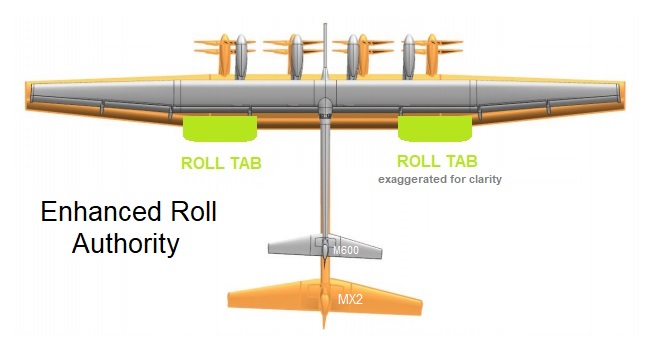MX2
- root: Makani
Power
- Advancing on the conceptualizing of MX2 is occurring.
- "We support MX2 as part of a balanced global AWE-testing program."
~ kPower, Upper Windpower, AWEC2020 Teleconference, EnergyKiteSystems, KiteLab Los Angeles, ... - v
Send
AWE notes and topic replies to editor@upperwindpower.com
Going back over the MX2 material for more open questions:
The uneven load distribution between the upper and lower turbines can be somewhat mitigated by rotors with different pitches, with higher pitched upper rotors. Trying to solve Pitch-Back with wider spacing based on the sim lacks a conceptual basis, and may have a hidden trade-off. Collective thrust and resistance to Settling-Under-Power may be reduced, and this should show in the sim, if looked for. Settling-Under-Power is one of the gravest risks scaling up VTOL capability under square-cube-mass constraints.
All unblown control surfaces reverse during settling tail-first. Recovery may depend on reversing control inputs without latency upon onset of settling.
An interesting proposal to TLG would be a virtual fly-off of all major AWES architectures. They would be ideally capable of integrating AE numerics with heuristics, since it is all rather a sketchy affair to model AWES.
KiteFast seems very under-developed still, for example, can't find any Tether Dynamics or (mass-dependent) Aerobatics physics, although poor documentation could be hiding what there is. Seeing a BYU connection to OpenFast, which may connect to BYU M600 modeling we have reviewed (which neglected velocity-loss due to turbine-on-wing drag to reach unphysical conclusions). NREL has been a very disappointing player in AWE, and OpenFast/KiteFast does not seem to offer much advantage over other major aerospace CFD contenders, none of which is comprehensive (tethers, realistic wind, computable flight-modes, etc.), many of which are better supported and more developed.
Special priority should perhaps be given to a de novo AWES sim package capable of flying off all contending architectures in an integrated environment.
MX2, idea for roll
Lifting Humans by Kite Systems
The larger MX2 wing and tail will have greater roll inertia to overcome, but wider-set outboard motors will add greater torque moment to the roll-tabs.
http://www.energykitesystems.net/AirborneWindEnergy/MX2/Roll-Tab.jpg

dave santos
More Notes:
Control-reversal is a factor if flow reverses on Roll Tabs during rapid settling, but this could be managed by programmed fly-by-wire response.
Another issue was Bridle Collisions with Pylons, which may have contributed SN3 wing failure. 3 sec before failure there was collision, and the snub-up then may have acted on a strained Pylon-Root. MX2 potentially allows more Pylon Clearance and Pylon roots may need extra structural design to tolerate collisions under load.
There was also the Tether-Foul with the Empennage in Norway. Rounded planform edges with asymptotic curves would hang-up less and even allow a small aerodynamic improvement. Reel-in should have been more aggressive and Retract Tether Angle not start so high. These are common toy-kite dynamics.
The Pitch-Back Effect in hover was simply that Rotor Array Center of Effort was above Tether Center of Effort. It was was not a "blown-wing" effect.
There should have been some visco-elastic Snub Shock absorption. Too often energetic traveling waves are seen on the tether concentrating shock forces at either end. Fishing poles and elastic snubbers at the leader are common to absorb shock force that would otherwise part fishing lines.